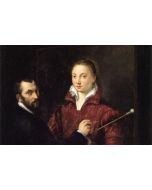Makers not muses: Claude Cahun, Eileen Agar and Isabel Rawsthorne
This course will be delivered online. See the ‘What is the course about?’ section in course details for more information.

- Course Code: VB659
- Dates: 25/04/24 - 09/05/24
- Time: 10:00 - 12:00
- Taught: Thu, Daytime
- Duration: 3 sessions (over 3 weeks)
- Location: Online
- Tutor: Chantal Condron
Course Code: VB659
Duration: 3 sessions (over 3 weeks)
Please note: We offer a wide variety of financial support to make courses affordable. Just visit our online Help Centre for more information on a range of topics including fees, online learning and FAQs.
What is the course about?
Artists Claude Cahun, Eileen Agar and Isabel Rawsthorne have in recent years enjoyed a revival as practitioners of exciting and experimental art forms. Cahun and Agar escaped comfortable backgrounds to pursue independent paths amid the avant-garde of the 1920s and ‘30s. With an inventive photographic practice, Cahun produced some of the most startling examples of self-portraiture of the period. Challenging gender norms in France, Cahun changed name and sexual identity in 1914, a pioneering act that reflected a playful subversion of the role of ‘muse’. In German-occupied Jersey, Cahun and partner Marcel Moore utilized art and poetry as powerful forms of resistance.
Photographer, painter, sculptor and collagist, Eileen Agar was inexhaustibly curious about the world around her who regarded the flotsam and jetsam found on a beach no less important than oil paint or watercolour in her art. A friend and associate of the leading avant-garde artists, poets and writers in Paris and London, Agar was an important figure in the British Surrealist movement and one of the few women to exhibit in the international Surrealist exhibitions of the 1930s.
Isabel Rawsthorne’s identity has long been regarded solely as the beautiful muse, a woman who frequently posed for lovers or friends, including Jacob Epstein, Alberto Giacometti and Francis Bacon. New research into Rawsthorne’s own work as a painter and set designer in Paris and London up to the 1960s, has revealed an incisive artistic eye and her defiant commitment to radical art and ideas. Like Cahun, she supported the War effort through her provocative ‘black propaganda’ drawings created for a top secret unit of the Foreign Office. Painting in a style that was neither purely figurative nor abstract, Rawsthorne’s distinctively ethereal works explored themes of human and animal life, nature and mortality.
This is a live online course. You will need:
- Internet connection. The classes work best with Chrome.
- A computer with microphone and camera is best (e.g. a PC/laptop/iMac/MacBook), or a tablet/iPad/smart phone/iPhone if you don't have a computer.
- Earphones/headphones/speakers.
We will contact you with joining instructions before your course starts.
What will we cover?
-A focused study of each artist and examples of key artworks each week.
-The social and cultural context in which each artist lived and worked covering the period from the 1930s to the 1960s.
-How each artist defied the convention of being a ‘muse’ by taking control of their art practice.
What will I achieve?
By the end of this course you should be able to...
-Identify one to two artworks by each artist
-List some of the materials and processes used by each artist.
-Describe how each artist used their work to challenge traditional social conventions of being a female artist.
What level is the course and do I need any particular skills?
This course is suitable for all levels.
You should be able to follow simple written and verbal instructions, demonstrations, hand-outs and health and safety information.
How will I be taught, and will there be any work outside the class?
You will be taught online via Zoom with lecture, slide presentations and group discussions. Handouts will be provided by your tutor to support your learning on the course; these handouts will be available online/digitally for download via the college’s Google Classroom. You will be sent an invitation to join the Google Classroom within a week of the course start date.
Are there any other costs? Is there anything I need to bring?
You might wish to bring a notebook. You might wish to buy some of the books on any reading list given out in class.
When I've finished, what course can I do next?
Feminism in modern and contemporary art
Women in art 1800-1900
Women in art 1900-1960.
Chantal Condron is a curator, teacher and writer with a dedicated focus on audienceengagement and enjoyment of art. As the UK Government Art Collection’s first curator of publicengagement, she led education and public programmes at the University of Hull, WhitechapelGallery and Birmingham Museum and Art Gallery, and delivered art talks at the Britishembassies in Paris, Vienna and Washington DC. She teaches Art History at City Lit, in additionto teaching the subject as part of City Lit’s Ceramics Diploma course. She is also an Art Historytutor for WEA London, and teaches 'A level' Art History to London secondary school students. Chantal has worked widely in the public and private arts sector for nearly 30 years including at Tate, Sotheby's, Visiting Arts, Arts and Business and University of London Library. She holds a BA in 20th century and non-western art from the University of East Anglia; and an MA in Asian art from SOAS, University of London. Author of 'Peter Hedegaard', the first monograph on the London-based Danish abstract artist who exhibited in the 1960s and ‘70s (Rocket Gallery, London, 2019), Chantal continues to contribute commissioned exhibition texts and reviews.
Please note: We reserve the right to change our tutors from those advertised. This happens rarely, but if it does, we are unable to refund fees due to this. Our tutors may have different teaching styles; however we guarantee a consistent quality of teaching in all our courses.
